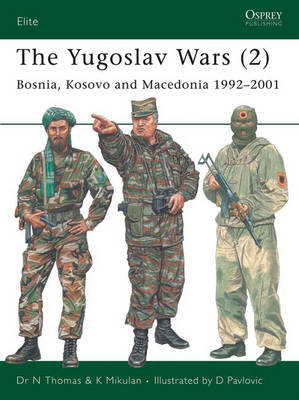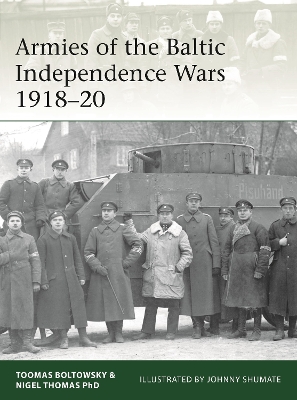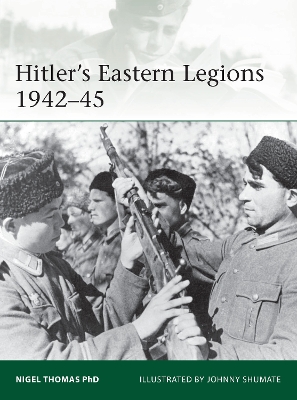Elite
3 primary works • 5 total works
Book 16
The defeat of Hitler on 8 May 1945 left Western Europe militarily vulnerable and economically exhausted. The Soviet Union, however, had since 1940 annexed 180,000 square miles of Eastern Europe, occupied a further 390,000 square miles, and now seemed poised to advance still further westwards with its six-million strong forces. The increasing Soviet threat brought forth demands for a permanent Western Military alliance, and on 4 April 1949, the North Atlantic Treaty was signed in Washington DC. This book explores the history, organization and uniforms of NATO armies - excluding the United States and Great Britain - as they were in the late 1980s.
Book 146
Following the death of the Yugoslavian strongman President Tito in 1980, the several semi-autonomous republics and provinces that he had welded into a nation in 1945 moved inexorably towards separation. As the world watched a series of wars ripped through this modern European state. In this second of two volumes, experts on the Balkan region give a clear and concise explanation of the armies of the Croatian War of Independence 1991-92 and the Bosnian Civil War 1992-95. This includes the regular and militia forces which fought in these campaigns and which ultimately resulted in the UN/NATO policing of Croatia and Bosnia that continues to this day. The book details this fascinating conflict and is illustrated with rare photos and an extraordinary range of colour uniform plates.
Book 218
In World War II Germany's doctrine of mobile warfare dominated the battlefield. By trial and error, the Germans were the first to correctly combine the strength in tanks and in mobile infantry and artillery. This integration of mobile units, equipment and tactics underpinned Germany's successes in the first half of the war. As the war dragged on, the Allies sought to copy German tactics but German armies remained supreme in this type of warfare until their losses had seriously degraded their capabilities.
This study traces the development of the different types of unit that came together in the Panzergrenadier branch from the inter-war years through World War II. Using colour plates to display the changes in uniform, equipment and insignia in all theatres of operations throughout the conflict, this is a complete account of Hitler's elite armoured infantry.
This study traces the development of the different types of unit that came together in the Panzergrenadier branch from the inter-war years through World War II. Using colour plates to display the changes in uniform, equipment and insignia in all theatres of operations throughout the conflict, this is a complete account of Hitler's elite armoured infantry.
Armies of the Baltic Independence Wars 1918-20
by Nigel Thomas and Toomas Boltowsky
Published 18 April 2019
Immediately following the end of World War I, amid the collapse of the German, Austro-Hungarian and Russian Empires, bitter fighting broke out in the Baltic region as Poland, Finland, Estonia, Latvia and Lithuania struggled for their independence, and Red and White Russian armies began their civil war. There were also German forces still active in what had been the northern end of Germany's Eastern Front. This book offers a concise but detailed introduction to this whole theatre of war, focusing on the Estonian, Latvian, Lithuanian and relevant German and Russian forces, plus Finnish, Danish and Swedish contingents. For each region there is a detailed map as well as meticulous orders-of-battle and insignia charts. Detailed for the first time in the English language, this fascinating book concisely tells the story of the birth of these Baltic nation states.
Between 1941-45, the Germans recruited around 175,000 men from a number of minorities in the USSR, distinguishing between 'Turkomans' (predominantly Muslims) and 'Caucasians' (predominantly Orthodox Christians). Of these, many formed rear-area auxiliary units, but at least 55,000 were combat troops. The first recruits formed two battalions in the 444th Security Division raised as early as November 1941; during 1942- 43 seven legions were formed, each of several battalions, eventually totalling some 53 battalions (equivalent to about 6 full divisions). However, with one exception (162nd Turkoman Division), they were not deployed as whole formations; after training in Poland, individual battalions were posted to fill out German regiments in the front lines, at first in Army Group South but later in all three Army Groups fighting on the Eastern Front. Units were also sent to Yugoslavia, Italy and the Western Front.
This fully illustrated history of the Eastern legions details the organization, battle orders, combat history, uniforms and insignia of these unique units, combining contemporary photographs and full-colour illustrations with expert research from military historian Dr Nigel Thomas.
This fully illustrated history of the Eastern legions details the organization, battle orders, combat history, uniforms and insignia of these unique units, combining contemporary photographs and full-colour illustrations with expert research from military historian Dr Nigel Thomas.




